#eusocial hierarchy
Explore tagged Tumblr posts
Text
deep rock galacticglyphid post
drg is my latest hyperfixation i think i love this game so mcuh ive been thinking aboutthe glyphids a lot and their biology im not super knowledgable on bio i just really like the topic so i might get a ton of stuff wrong but idc disclaimer: because glyphids evolved seperately from earthbeings (duh cuz they're on hoxxes not earth) any similarities to earth creatures is most likely just convergent evolution extraterrestrial life could be extremely similar like the glyphids or completely different its all speculative. anyway, first things first: Bone Game
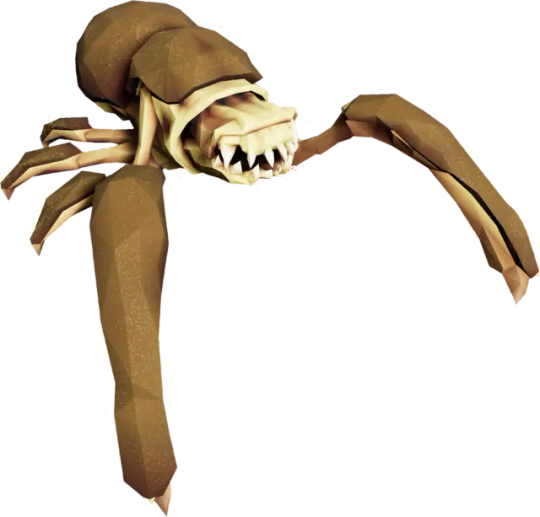
ok lets look at the glyphid grunt for a sec. Glyphids have two body segments, a head and an abdomen, and eight legs. Their front legs are usually enlarged for burrowing, attacking, and defending. These vary in size and shape depending on the bug. (most glyphid variants look like they have three body segments, such as the grunt shown above, but i believe that its just a protruding jaw as when it moves its head its entire body moves with it, and the Warden specifically has a much more obvious two-segment body plan due to its lack of sharp teeth and massive size difference in body and head) They may or may not have eyes, indicating that eyes were a trait they lost when they went underground. What separates them from spiders is their size, ability to vocalize, their eusocial hierarchy, and the fact that they probably have bones. Earth spiders are invertibrates, like all arthropods. We haven't seeen a glyphid skeleton completely before, but there is a lot of evidence pointing towards their true bony nature. They dont have typical exoskeletons that cover the entirety of the animal. They have "chitinous armor plating" as described by the bestiary that resembles more the armored back of a crocodile than an actual exoskeleton. This plating can be removed in battle and not impair the glyphid's movement, in stark contrast to an earth bug which if you removed its exoskeleton it would just be a pile of bug organs. Exoskeletons double as their skin. Also glyphid sw
armers have no armor and still are fine moving around. They also have defined teeth and jaws, unlike the mandibles on an earth arthropod.
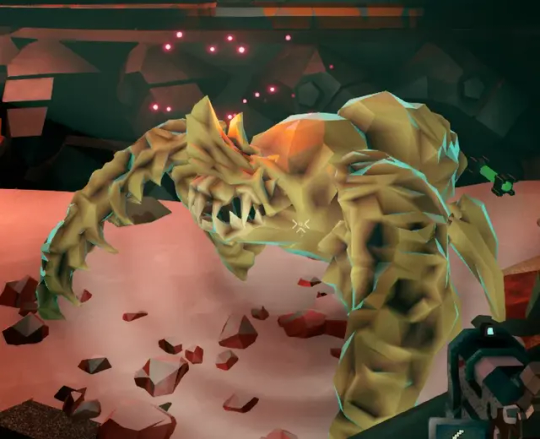
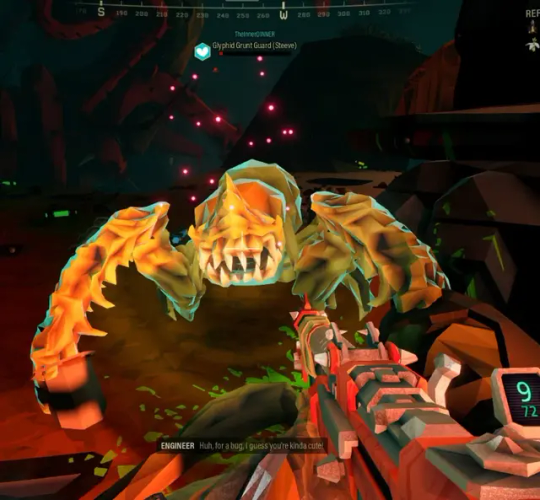
(peeled glyphid grunt guard)
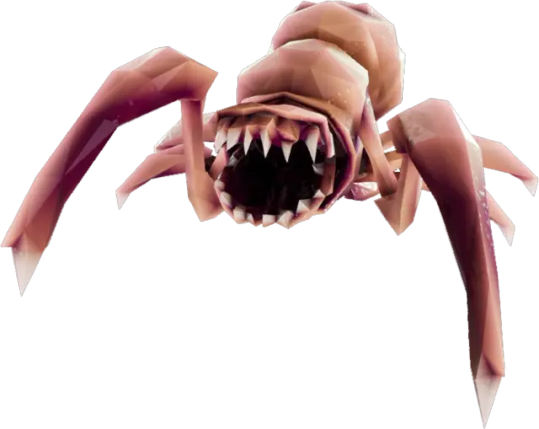
(glyphid swarmer with teeth and jaw visible) Lastly, and I'm not too sure on this one, but i dont believe an exoskeleton made of chitin could hold up a glyphid, yet alone some of the bigger ones. Praetorians are the size and weight of a midsize SUV, and they're not even the biggest glyphids get.
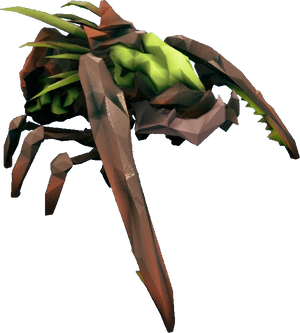

Solitary vs Eusocial
If you got this far you're autistic about animals like me and probably know what eusocial means. If you don't, it just means there's a queen and workers. Think ants, wasps, and bees. While it's generally a consensus that most glyphids are eusocial under one Queen (we'll talk about her later), I think not all of them are. The bestiary says that glyphids are a genus, not a species, meaning that different glyphids can evolve seperately from one another and can be able to live independently instead of in a caste system. Of these, I think the beasts most likely to be solitary are the Stalker, Menace, Stingtail, and Septic Spreader. These guys have extra tools and divergent behaviors (sneaking up behind you, digging around, keeping a distance to shoot projectiles) that seem, to me, like they are taking advantage of the fact you are preoccupied with the glyphid colony and trying to snatch you up as prey for themselves.



(from left to right) stingtail, septic spreader, stalker (below) menace
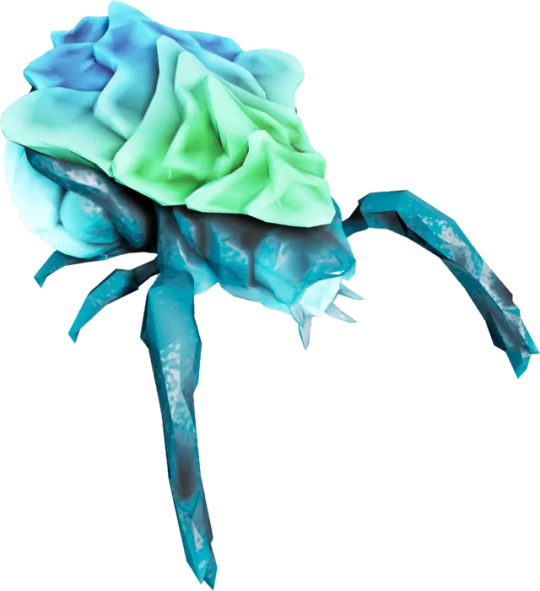
It also explains why, in some locations, there are random batches of glyphid eggs out and about. It could be this could be a clutch of one of the aformentioned solitary glyphid eggs, and all glyphids look the same when they hatch.
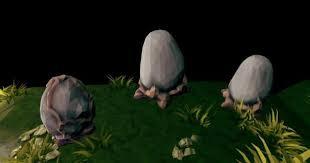
These swarmer nests could either be from the glyphid colony (we are in their territory, after all) or just a different variant of glyphid.
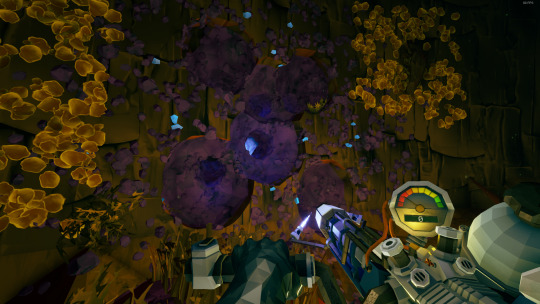
( the blue gem is not supposd to be in there usually, just the purple circles. I couldn't find a better picture.) insert super smooth segue into :
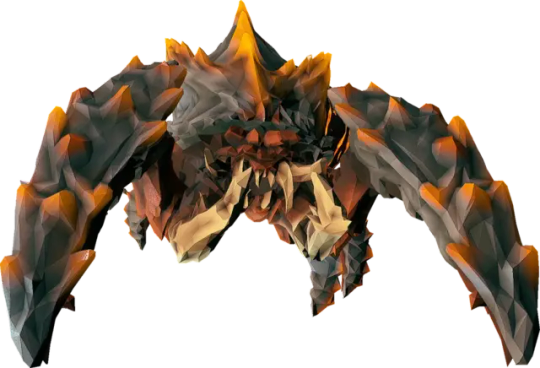
Glyphid Hierarchy

apologies for the crunchy image but i put together this tierlist to explain how I think the glyphid hierarchy works. The tierlist didn't have the stalker in it but it would have gone in solitary for reasons Ive mentioned.
Notes: Soldiers are specialized for fighting but they all have different roles. Slashers and exploders tend to flank and sneak up on their target, the latter being born literally just to die. Praetorians and oppressors are meant to soak up attention and, in our case, damage. Web and acid spitters are meant to take care of flying enemies ( probably mactera in the wild, but in our case it's dwarves on a zipline), and wardens support the ground enemies. the green baby glyphids that are in the solitary tier are called Glyphid Spawn, and they aren't actually a glyphid; rather, a fleshy monolith called a Brood Nexus (below) had taken the DNA of a Glyphid and created their own version of swarmers with it. icky.

Mutations and Anomalies
Certain bugs such as the Bulk Detonator, Dreadnought Hiveguard, and dreadnought twins are anomalies that either don't occur naturally or an unintentional byproduct of biology doin its thing. The Bulk detonator "is what happens when an exploder manages to not detonate during its volatile, and usually short, life." This description pretty much spells it out that these guys aren't supposed to exist.
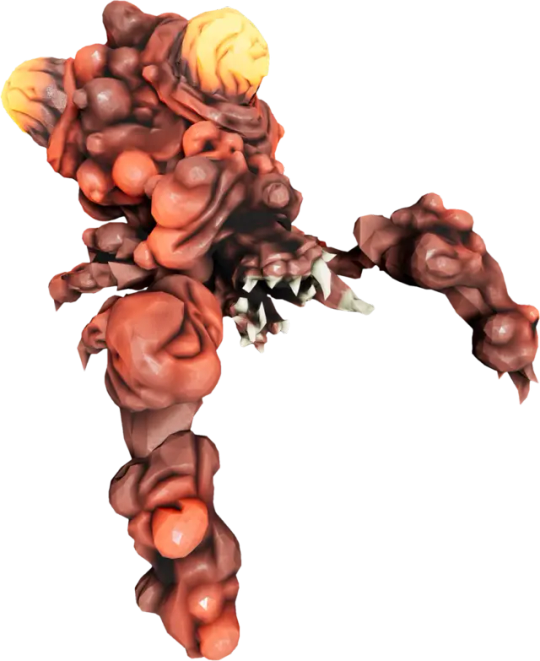
also, look at their mangled faces and bulbous, pustuled bodies. Exploders are meant to be sent out and explode. I don't know what the glyphid colony does with these, but I don't think they let them stay. Too volatile, and positively humongous. They're the biggest glyphids by far and i think glyphids just wouldn't let them be.

I have no clue how the Crassus Detonator exists or how it turns an entire crater into gold when it explodes. The Dreadnought Twins are a Dreadnought that split into two in the cocoon. Assuming dreadnoughts pupate into queens (more about that below), it's likely that they would pupate into two queens, with possible ramifications outside of that (perhaps sharing energy in a cocoon means inhibited reproduction in some way?) I doubt they'd fight over power, because the dreadnought twins show impeccable teamwork when broken out, even to the point of one dreadnought will sacrafice some of it's health for the other if one gets too low.

dreadnought twins The Dreadnought Hiveguard is the closest we've got to actually seeing a Glyphid Queen. It's a dreadnought that's been baking for a while but hasn't gotten all the way there. It's impenetrable from everywhere and can spawn Sentinels to protect it. It then reveals three weakpoints on its face when all Sentinels are killed, and then reveals its booty weakpoint when the face weakpoints were deaded.


(from left to right) Hiveguard, Sentinels Because Sentinels don't come from the cocoon and dont spawn in any other area, my best guess about them is they lay dormant usually, letting the other glyphids fight. They only respond to the Queen, being her last line of defense. It'd make sense because the Hiveguard is the closest thing to a queen we've got, and it has a unique vocalization for summoning Sentinels.
Dreadnoughts, Praetorians, Queens, and Conservation
The glyphid dreadnought, at its base form, seems to be a grander Praetorian. They look similar, down to the tusks on their face, and even have similar attacks. They carry the same bite and slash that nearly all ground glyphids have, but they also have a projectile shot from the mouth.
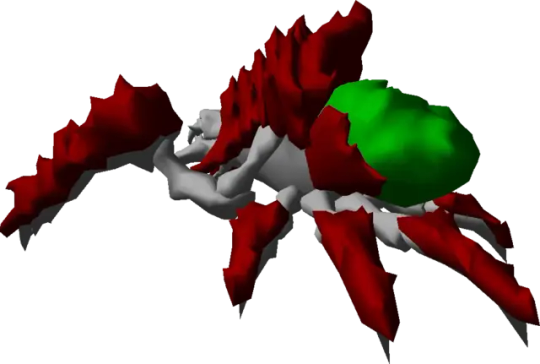

(from left to right) Praetorian 3d Model, Dreadnought 3d Model If I had to guess, this could be a Royal Jelly Moment. To explain, lets look at earth honeybees. These guys are fed a substance called "royal jelly" as a larva until they are fed honey. Certain workers, though, are fed and fed and fed and even have the walls of their honeycomb cell lined with the stuff. These workers end up becoming juvenile queen bees and they start their own colony. Given the fact that Oppressors are canonically "aggresively mutated Praetorians", I believe they are simply praetorians that weren't fed Royal Jelly. Their armor grows, and their weakpoint abdomen shrinks.
In the game, it's heavily implied that the glyphids are without a Queen (the voiceline "Die like your mother did!" when killing glyphids comes to mind), and the only time we ever see a Dreadnought is in a cocoon, outside of the rare times it spawns on an unrelated mission. We are told explicitly that these guys arent in their final form and they will pupate into something much worse if we don't stop them, and there seem to be a lot of cocoons around. (There are 2-3 cocoons a mission and there is always an elimination mission available.) What i think is happening is Praetorians are mutating into Dreadnoughts which are further trying to mutate into Glyphid Queens to fill the empty spot in the glyphid hierarchy and they want to spew out so many glyphids that the mining operations on Hoxxes has to close down. This has a lot of implications. Firstly, glyphids are so plentiful without a queen. Imagine how insane they'll get with one. Secondly, glyphids are numbered. They aren't being replaced and DRG is killing hundreds of them a mission, potentially thousands on Deep Dives and Elite Deep Dives. (I tried an elite deep dive earlier today, got to about 897 dead glyphids on the third mission which i inevitably failed). Thinking about this really puts into perspective the damage DRG is doing to Hoxxes in the pursuit of more money and resources, polluting it with depleted uranium and plasma radiation and drill fumes and omoran heartstone lazerbeam juice and abandoned mining equipment, sucking it dry for its resources, and actively killing the rest of the wildlife that havent died from habitat loss. Glyphids are not the villain of this story. They are just following their instincts. It reflects how real-world corporations simply don't care about the earth that gives it its wealth and gives us life. I didn't mean for this rant to end the way it has, but please be grateful for the earth you stand on, appreciate nature, and don't litter. Also, if you haven't, play Deep Rock Galactic. solid game.
if only there was some salute or chant i could say to end this with a bang, one involving rocks, or stones, or something
#drg#deep rock galactic#glyphid#theory#biology#spec bio#special interest#loser#karl#deep rock#autistic
57 notes
·
View notes
Note
Orc breast anon. Thank you for answering. I’d thought I’d add some extra context about my orcs & goblins and some of the ideas I have currently on their reproductive biology and habits. See if their any suggestions or tips to help improve them.
My Orcs are your typical WoW/ Elder Scrolls kind (brutish and savage, but not innately evil). Orcs have an uneven gender ratio with more males then females, at a ratio of about 1-3. Orc women have induced fertility rather than a set fertility cycle, only needing an orgasm for pregnancy to occur. Twins and triplets are the norm for orc births, single births being rare and considered a bad omen. Orc women have between 4-6 breast, only the top set is really prominent, the bottom pairs being significantly smaller and only really growing in size when an orc women is either pregnant or overweight. Orc society is quite misogynistic and males being highly competitive, females being reduced to prizes to be won and not much else. The more wives and children you have the higher your social status among orc men. Orc men who are branded criminals/ cowards/ or otherwise shamed are castrated and made into borderline slaves, these eunuchs occupying the lowest rung of orc society.
My Goblins are also the typical variety, except they have a reproductive biology and society built like meerkats/mole rats. Goblin social structures are split between reproductive and none reproductive members, with the breeding females being at the top/ followed by their male mates/ and at the bottom the none breeding females and males. Breeding females birth whole litters of offspring, usually between 4-8 babies per batch. Goblins have induced fertility as well, but also the ability to be impregnated multiple times, each litter having multiple genetic fathers. Goblin women have 8 nipples, though breast are only visible on the breeding females due to a mix of hormones and repeated pregnancies. Babies are only kept by the bio mother until weaned, after which they’re handed off to care takers to finish raising them. These lower goblin care takers are who name the children/ assign them a future role and social class/ and other prominent parental duties. Even in more liberal goblin societies is seen as highly taboo for a goblin women to get pregnant without being ascended to breeding status, often being punished brutally. In the best case the mother and her offspring will be branded and banished, at worse the mothers sterilized and her babies killed before her in the more tyrannical goblin cultures.
I think the biology you've worked out for them is great! It's always fun to see fantasy people that have unique non human biology and reproductive habits. I've done similar with my own drow, basing their reproductive habits and social roles on the eusocial naked mole rats even though they're primates. Like if baboons were people but also eusocial cave creatures haha.
Meerkat goblins are a really fun idea, I love that.
I do have some personal concerns about the fact that you're portraying both of these groups as "brutish and savage" in some way or another, but I understand that you're going for a more common expectation with how they're usually portrayed.
Thing is, words like brutish, savage, and barbaric, while they don't necessarily always mean "innately evil" have still been used irl to describe indigenous people in many parts of the world, as an excuse to colonize their lands and "fix" them or eradicate them because they're "uncivilized". So at the very least I'm going to just caution you on how you're portraying these fantasy people and ask that you double check your worldbuilding for any parallels to real life groups.
Here are a few questions to help you check your writing:
Are the orcs and goblins the only groups that show this level of misogyny? Are they the only ones who are this strict and harsh with their social hierarchies? Do other groups in your world, like elves, also have extreme negative social traits like this?
What does the architecture look like for the orcs and goblins? How about their clothing and tools? What unique advancements do they have that other people do not? Or are they significantly less advanced than other people? Are their homes and clothing simple in a reasonable way or in a way that makes them look almost useless?
Even if you're not portraying orcs and goblins as outright evil, do you give them space to show good and positive traits as well? Do you portray other people with a higher number of positive traits in comparison?
My purpose with this blog is not to stop anyone from following their own ideas, but since I have advocated for more nuanced portrayals of all fantasy people, I feel some obligation to warn you that the way you've described your orcs and goblins will probably feel rather racist to some audiences.
But I'm also an advocate for fantasy that explores darker topics, so if you think you can handle these portrayals with nuance and make it work, then all power to you.
I myself have written orcs to have a history of hunting centaurs, and that history is messy and bloody and full of questions about where the line can be drawn between animals performing natural behaviors in a morally neutral manner, and people behaving cruelly. So I'm not going to tell you you have to drop all the negative aspects of these orc and goblin portrayals and make them super nice and good, that's not really how trope subversion works. I'll just tell you to make sure you're not leaning so hard into the negative traits that it overpowers any positive trials they might have. Be nuanced with them! They're still people.
16 notes
·
View notes
Note
Hmm do you have any he's about before mother grub troll society?
So, my timeline wwvithin GD is that the existence of the domesticated mother grubs, and therefore the beginnings of the empire, actually predates The Condesce.
8ut, trolls are not all that wwvell adapted to the nomadic conquering life style the empire promotes, or the heavvwily homogenized culture its trying to devvwelop.
Trolls are Eusocial Territorial Pack Hunters That livvwe in groups of similar ages.
8ack in the day, a Hivvwe of trolls, (more specifically: a tine of landdwellers, an alley of clowwvns or a Maw of seadwwvellers) wwvould be a group that all hatched at the same time in the same group. There wwvould be a loose hierarchy among the group, based on an evvwer shifting pecking order, and they'd set up in a single hivvwe and keep a territory of sevvweral dozen miles in any givvwen direction, except coastal groups, wwvho wwvould migrate up and dowwvn the shoreline, swwvapping territories wwvith other hivvwes.
Certain hivvwes that had ovvwerlapping territories wwvould co-exist fairly quietly, unless completion for resources spiked. This often resulted in coalitions, groups of hivvwes swwvapping territories, backing each other in hard times, and interbreeding.
A clutch of eggs, and the grubs from those clutches, wwvould all produce a specific pheromone that marks them as part of the group.
Modern day, this pack behavvwior is only observvwed in jade bloods, the church, coalitions of seadwwveller nobility, and the orcinic cult.
It wwvas the Empress before Condy wwvho started the mandate of mother grubs, because evvwer growwving coalitions of trolls could potentially reject her steady takeovvwer of their territories. It wwvas like the industrial revvwolution on earth, a sudden increase in urbanization that forced out the old wwvays, for better, or for wwvorse.
That said, because of the wwveird paradoxical nature of the beta and alpha trolls, the wwvhole clone thing, and the lab growwvn aspect...
Wwvell, there's a reason they aren't all getting super territorial. They're all technically clutchmates.
5 notes
·
View notes
Note
Are the Schistocerca gregaria, Locusta migratoria, Nomadacris succincta, and Anacridium sp grasshoppers/locusts still around? And, can they still become gregarious?
Oddly specific question, I was just thinking about how crazy yellow ants are the only eusocial insects in where we are in the story. But locusts are….weird.
(p.2) Well I guess locusts aren’t really *eusocial* as they don’t have a social hierarchy like ants do, but gregarious behavior still seems like a threat.
On the contrary, the ants view the grasshoppers the least of a threat of all macrovolutes! In the notes for episode 6, you can read a little on how Grasshopper Swarm is regarded as a non-Swarm, because the grasshoppers believe gathering in large numbers is bad luck...because of the locusts, yes! Locusts are certain species of grasshoppers which form devastating swarms during periods of starvation. As macrovolutes, all grasshoppers vow never to form groups that large, under any circumstances. They're anarchists, and don't fully understand how laws work when they are among insects that belong to Swarms.
And there's nothing the ants like better than a big, fat, lonely insect that has a poor grasp on laws. It wouldn't be an exaggeration to say the ants view the grasshoppers as sort of free range cattle, for when stocks of isopods and millipedes are low. Or, even when they're not.
In real life, gregarious behavior is not at all uncommon for insects, though true sociality is. You can very often find insects of the same species gathered around a food source (aphids, other true bugs, flies, roaches, etc.), or just clustered together to hibernate (e.g. ladybugs). The ants in HBG do not regard this as a threat, and in fact, the other macrovolutes were pressured to form *some* kind of social structure to convince the ants they were worth dealing with at all!
20 notes
·
View notes
Text
WASP REVIEW - ZINGER (DONKEY KONG SERIES)


[Image IDs: Two renders of the Zinger from DK: Jungle Climber and the original Donkey Kong Country respectively /End IDs.]
and were back to the wasps based entirely on eusocial species! This time, the basic Zingers (although having a few different recolored iterations) look the most like some black and yellow species of paper wasp or yellowjackets. Given Rareware's home of operations and the homeland of designer Steve Mayles, being England, I feel like it's fairly safe to assume that they're based on one of three species of wasp: the common wasp (Vespula vulgaris), the European wasp/German yellowjacket (Vespula germanica), or the European paper wasp (Polistes dominula)!


[Image Sources: Wildlife Insight, and Wikimedia Commons, Sharp Photography | Image IDs: Two photos of yellow and black wasp species, the former being the common wasp, a type of yellowjacket, on a grey wood surface, and the latter being the European paper wasp on a stone or concrete surface /End IDs.]
They're not entirely accurate; the markings aren't too precise, they only have two wings as opposed to the four on a real wasp (Although the DK: Jungle Climber iteration changes their shape to at least imply a second pair), and obviously real wasps don't have a trail of spines/stingers running down their metasoma nor a pair of signature Rareware cartoon eyes. However, the original model especially is surprisingly accurate for being based on an animal that the designer himself said he was scared by! I especially appreciate the original's fairly accurate legs and addition of setae!
It's in the games themselves where we run into more inaccuracies to these particular species, however. In the original DKC, the queen of the Zingers is named Queen B. and is fought on the boss stage titled 'Bumble B. Rumble', clearly being a direct reference to real world bees, which are several familial branches away in the wasp subclade Aculeata from the previously listed Vespids. This is honestly, while a little frustrating, not a big deal. But, when we get into the second game in the DKC line, we discover their hives.
The Zinger hives throw a major spanner in the works. The wasps mentioned make paper nests, with the yellowjackets nests having a round, closed structure, some yellowjackets building inside of trees or in dirt burrows, and the paper wasps having an open, umbrella-like structure both including cells built in hexagonal shapes, built to contain their larvae and often having silk caps covering them. Meanwhile, the Zingers have nests that match the hexagonal cells, caps, and larvae of these wasps, but are clearly made of yellow wax and contain honey, like that of honey bees.


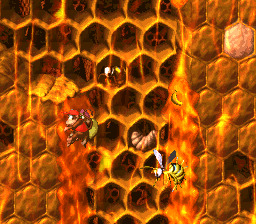
[Image Sources: Carolina Honey Bees, and Wikimedia Commons, Dicklyon | Image IDs: Two photos showing the nests of the western honey bee and the european paper wasp, followed by a screenshot of one of the Zinger's hives /End IDs.]
Honey bees will also cap their honey and larvae with wax, and while a few notable species of Vespid wasps do, in fact, produce honey, the european paper wasps and yellowjackets are not a part of that particular set of species! Oddly, some of the cells appear to contain notably smaller adults as opposed to other cells that contain larvae. To add further confusion, one of these hive levels is titled 'Hornet Hole', hornets being another completely different genus within Vespidae (Vespa).
On top of all that, at the end of the area that contains the hive levels, Krazy Kremland, you fight another Zinger boss, this time named King Zing. As you may know, no wasps have a 'King', solely having a Queen, with hives having both Kings and Queens among eusocial insects being moreso found in termites, belonging to a completely different order (Blattodea).
Outside of their nesting behavior and hierarchy, their behavior is generally unremarkable for platformer enemies, with amped up aggression from that of a real world wasp (although admittedly not nearly as aggressive as a real world wasp would be if you were a monkey with a baseball cap and an unquenchable thirst for bananas invading their nest, as you play in DKC2) to give the player an obstacle to overcome in these levels. It is, at least, implied that these wasps would collect nectar from flowers to turn into the honey found in their nest.
Plus, as I wondered in my review of Fallout: New Vegas' Cazadores, I have to question what exactly a wasp of such a size hunts to bring back to its young! Hopefully Donkey or Diddy Kong wouldn't find themselves on the menu!
All in all, these wasps get a few things right, but are quite the mixed bag of confused species with a couple outright inaccuracies not found in Hymenoptera in general thrown in there. Though I can commend the effort by the designer!
-
Overall: 4.5/10
-
Leave your wasp review suggestion in the replies, tags, or askbox!
Make sure to tune in next week when we cover the Circuit Bees and Mask Hornets from Lethal Company!
11 notes
·
View notes
Note
For the Ask game!!!
C
Wow, I actually think I only have one oc with a C name lol
Cari Vos, early 40s, Li/Lir pronouns. No nickname. Li is a drow, so rather than having a gender, lir pronouns and terms of address are based on lir role in the eusocial colony hierarchy. Cari is a baronet, one of the infertile female drow born as twins to the silk-producing spinnerets.
Cari is demisexual and romantically attracted to people of a feminine presentation. Drow have a difficult time defining their own sexuality and romantic orientations, as they typically experience a very asexual life, surrounded by their siblings and other family members, and only discover attraction, if they have it, when they leave the caverns and spend more time on the outside world (during which time, many cavern drow will temporarily use the terms of address for a minstrel drow, traditionally the males who live a nomadic lifestyle rather than settling down with a Matriarch. In recent years, the terms for minstrel drow have been expanded to any drow currently living outside the caverns, if they choose to refer to themselves as minstrels)
As for the other things on the list, that's tricky because Cari was only created so my other drow oc Xulic can have an obligatory twin. So I haven't fleshed lir out as much as some of my other ocs!
Song I associate with Cari: n/a, I don't really pair songs with ocs most of the time. There are a few exceptions.
3 important relationships: Xulic, Cari's twin. Ametrie, Cari's dwarvish girlfriend. And Marai Vos, the Matriarch of Cari and Xulic's colony.
2 fears: Cari shares the common fears of most baronet drow. First is the loss of lir twin. Very few things can strike fear into the heart of a twinned drow like the fear of becoming twinless. It's a relationship that exists from the moment they're born, a bond that cannot be replaced. Even living apart from each other, as adults, this worry lingers in the back of Cari's mind every time Xulic goes on a work trip as a geologist/paleontologist.
The second fear is accidentally triggering the natural processes that can turn baronet drow into Matriarchs. All baronet drow have this potential, but usually the only become Matriarchs is they choose to go through the trials to prove themselves worthy of it and then undergo a series of careful medical treatments to initiate the secondary puberty that turns them into fertile child-bearers. Most baronet drow want nothing to do with this, but it is known that sometimes a drow living outside the caverns will accidentally find more natural triggers for the transition. Cari has avoided this fate, and hopes to keep avoiding it. It's a rare occurrence, but the slim chance is enough to make lir wary of spending too much time living outside the caverns.
A backstory detail: Cari only left the caverns because Xulic really wanted to attend university. Some drow never leave the caverns, and Cari was reluctant to venture outside, but in their early adulthood Cari and Xulic still clung to each other and did everything together, so Cari left with lir twin. Li did not expect to enjoy university and didn't really plan to do much there, but much to lir surprise, the subject of math, which li was already good at back home, became a total fascination. Cari now has a whole degree in math at a far higher level than li learned in the caverns, which makes lir a very important asset to the colony.
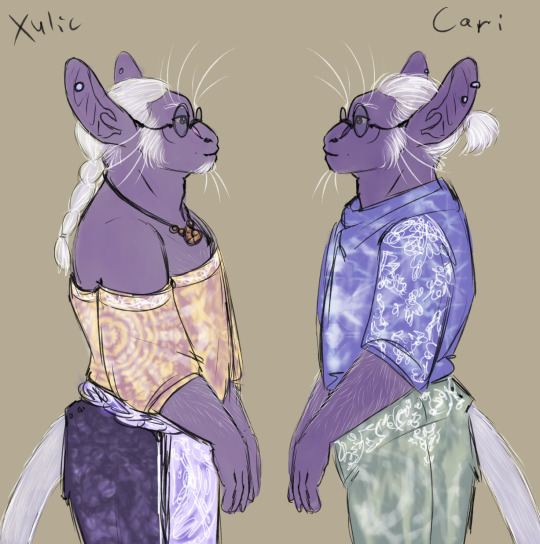
(Image description: two drow, Xulic and Cari, facing each other. They have nearly identical features and wear similar shaded glasses. Xulic has longer braided hair and a little goatee while Cari has much shorter hair in a small ponytail. Xulic is wearing looser clothes with exposed shoulders while Cari wears a sweater with a higher neckline. Xulic's purple skin is also paler than Cari's. End description)
Bonus note: the level of purple in a drow's skin is directly correlated to the amount of cave snails they eat and how frequently they eat them.
4 notes
·
View notes
Text
Draconic Sociality
Many species of dragon are social. However, there are different levels of sociality, and dragons, like most animals, fall into various categories.
Level 0 - Solitary
Several species, such as Skrills and Armorwings, are highly territorial and do not tolerate the presence of other dragons. They likely only tolerate the presence of their own kind, as adults, if there is an opportunity to mate.
Level 1 - Gregarious
Many species, including Nadders, Gronckles and Terrors, are gregarious. They congregate, either naturally or under certain conditions, for the sake of protection, company, easier access to mates etc. These groups are referred to as flocks. There are single-species flocks, such as those of Smokebreaths, and there are multi-species flocks. Within flocks, a loose hierarchy often forms.
Typically this is a case of Might makes Right. The bigger, stronger and more aggressive dragons tend to dominate over the smaller, weaker and less aggressive ones. Therefore, it follows logically that the biggest dragon in a flock, especially if they have no competition from their own kind, will become the ‘leader’ of the flock (also known as a Queen, King, alpha, defender etc.)
However, dragons do not behave solely based on instinct. They can and will recognise other qualities as being worthy of high status. (For example, Toothless is the de facto leader of the Berk flock not because he’s the biggest dragon, but because he killed the Red Death.) Dragons will naturally have friends and rivals within the larger social network of the flock.
Level 2 - Hierarchical
Several species, such as Changewings or Speed Stingers, live in single-species packs. A pack is distinguished from a flock by the more rigid social hierarchy and distinct pecking order they develop. The kind of hierarchy varies between species. For instance, Changewings have a social hierarchy similar to that of spotted hyenas, where females are dominant over males.
‘Pack’ used to refer to single-species groups and ‘flock’ to multi-species groups. However, further research into the social dynamics of dragons has revealed that a more accurate distinction would be that packs have a pecking order, whereas flocks are more generalised. The norm is to have multi-species flocks and single-species packs, but of course there are always exceptions.
Level 3 - Eusocial
Firewyrms (and possibly Prickleboggles) are unusual amongst dragons as they are eusocial. Eusociality is characterised by the following: Reproductive division of labor (with or without sterile castes), overlapping generations, and cooperative care of young. It is considered the highest form of sociality.
The Firewyrm Queen is the sole reproductive female within a colony. She reproduces parthenogenically, laying hundreds of unfertilised eggs that develop into non-reproductive drones. Genetically speaking, these are male, though functionally speaking they are sexless. The workers care for future generations, defend the colony and scout out new territory or food sources.
When a colony starts to get too large, the resident Queen will produce a special type of fire-comb gel called drottninghunang (lit: ‘queen honey’) that is laced with hormones. This gel is fed to one of the hatchling drones, though the mechanism behind which this individual is chosen is not yet understood.
The drottninghunang basically triggers their transformation into another reproductively-capable female, known as a Firewyrm Princess. When this female is large enough to fend for herself (and before she gets large enough to be a potential rival to her mother), she will leave the colony to start her own.
10 notes
·
View notes
Text
A Speculative Analysis about Bliblies No One Asked For
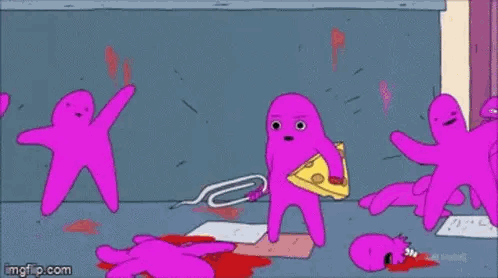
Upon their nature and just where they slot into the chaotic worldbuilding of the Smiling Friends, that is. Written by an actual pest control technician.
Starting off, we know for sure is that they seem to be a highly gregarious, nuisance species of critter.
While it may seem like they could be eusocial organisms, like ants or wasps, I highly doubt they actually follow the structure of such, as it involves a rigid caste hierarchy with one breeding queen.
We’ve only seen regular bliblies that do not behave in a very organized manner, so we can rule out hives and queens. Instead, I think the available evidence suggests that they are a common pest similar to invasive rats (meaning the cheese and mousetrap analogy might actually be intentional), which can live in massive social colonies in the wild.
Like rats, the bliblies also seem to be capable of an impressive amount of intelligence. They are able to cooperate enough to summon help in order to subdue a shared threat (Alan), but also are more than capable of turning on their own. It’s possible they may even become cannibalistic during periods of scarcity/overpopulation, which is a guess going off of the RL behavior of rodents and some insects. The actual hierarchical structure of a biblie nest to what extent it might exist appears to be a matter of might makes right. While active biblie hordes will share territory and behave as an overwhelming collective wave when threatened, the colony members still act as individual units competing for immediate resources such as food and tools.
All in all they appear to be a fairly dangerous household pest if allowed to take up residence in an area, breeding incredibly fast and nesting in large sacs, possibly for warmth, as small creatures loose body heat quickly.
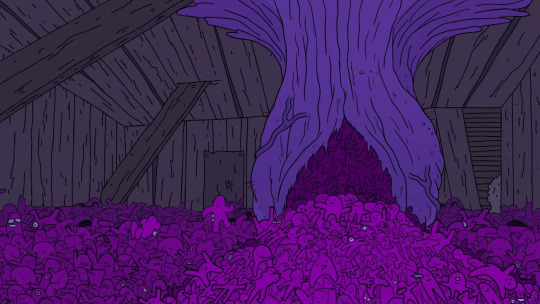
That said, it’s also possible that they nest together purely as a defense tactic. In the real word we see this in harvestmen, which clump together in huge balls of arachnids in order to ward off larger predators, and also scatter everywhere once disturbed.

Their biggest strength is in numbers and intelligence. They’re clever enough to run from a fight they clearly can’t win and alert the rest of their colony, but are individually quite fragile. They will even use this pathetic appearance to their advantage, feigning cowardice in order to lower their opponent’s guard. Likely, they resort to aggression as a last resort upon discovery, since they spend the earlier parts of an infestation foraging, growing numbers, and trying to avoid detection from their hosts. It’s more than a little concerning that some of them are capable of tool use to the point of arming themselves with improvised weapons AND replicating an execution by crucifixion. The fact that they have a rudimentary understanding of Christianity or at least ancient torture methods is also its own can of worms my biology education ain’t touching.
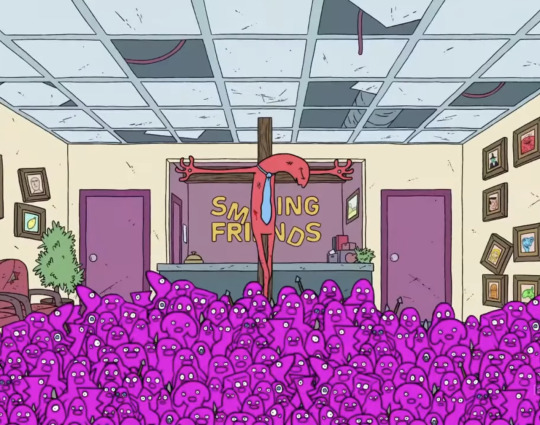
Now, if you forced me to guess how an infestation starts…. It’s tricky when we have no idea how they even reproduce. Either they don’t display any outward sexual dimorphism, they’re hermaphroditic like snails, or they breed asexually. Whatever the case, I’m willing to bet that they begin a budding invasion like roaches do. See, when one roach finds a great spot for scavenging food, they’ll mark the site with chemical signals that attract others of its kind to the area. Eventually, enough roaches gather in the same place and start spawning young collectively, hiding together in their own filth during the day, and emerging at night to hunt for scraps. And like roach infestations, one of the easiest ways to detect Bliblie harborage is the presence of feces (in their case, taking the form of “mysterious purple shit pellets”).

Likely, the best way to prevent a Bliblie infestation is keeping a clean space, sealing off entry points, and eliminating access to food- as with any similar issues. However, once a large enough nest has been established, the safest solution lies in a complete mechanical extermination of the colony. If they are smart and aggressive enough to nail you to a cross, they are going to be capable of plotting revenge in your sleep if you evict them and don’t finish the job completely. You’ll get a few of them with traps and poison, but the rest of them will only learn and adapt. Directly killing them all in one go, outright warfare, no survivors…. would be the most effective tactic. At bare minimum a decimation of the infesting population could help to break the morale of the survivors, which will be easier to push into vacating a structure once their nest site has been destroyed.

Which above else makes me so just glad we have such dedicated professionals like Desmond around to handle these creatures.
TL/DR: Bliblies are basically a smarter and scarier equivalent of Norway rats, or perhaps cockroaches.
#smiling friends#bliblie control#smiling friends bliblies#bliblies#repost from my old blog#scarlet talks about things#scarlet rambles about things
5 notes
·
View notes
Text
The thing about muriquis — they aren't great apes. Their brains lack structures for what is considered higher intelligence. That means that non-hierarchical sociality doesn't require higher intelligence. However, we have no evidence of higher intelligence without hierarchy, which could imply that the hierarchical structure of the brain necessary for higher intelligence may make hierarchical categorization inherent to higher intelligence. Cetaceans, corvids, primates, elephants, even canines if you want to consider them Higher intelligence all have social hierarchies. Even the definition of eusociality mandates hierarchical categorization of individuals... It really is a shame what has happened to muriquis. They would be great to study. Group social behavior without fighting for dominance and breeding access is exceedingly rare in mammals. I don't know enough about birds to apply the statement to them
9 notes
·
View notes
Text
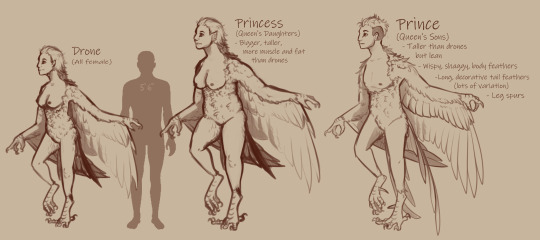


Decided to play around with harpies for my fantasy world and do something a little off the beaten path with them. They have a social hierarchy that is inspired by both poultry and bees. They're somewhat (but not entirely) eusocial.
Albethian Harpies are still behaviorally quite like a flock of birds, but also share some similarities to bees with their social hierarchy and sexual dimorphism.
Most harpies are drones, individuals with neutral brown and greyscale plumage who are exclusively biologically female. Drones are at the bottom of the pecking order, though what exact order is determined by their job and social standing with the queen. Unlike bees, these drones are still able to produce offspring, generally with extra sons of the queen if they are high ranking enough… but they will only produce more biologically female drones. There are very rare occurrences of drones producing male offspring, but they are often killed by the queen on being found. This is generally the case if a harpy and a human have a hybrid child while the mother is still within the flock. Hybrid harpies are looked down on and now allowed within the flock despite always taking more after their mother than their father.
Next up the hierarchy are the queen’s direct offspring. The queen is the only harpy allowed to produce sons, though it is still somewhat rare (1:5 ratio instead of 1:2). The queen’s daughters and sons are not any differently ranked from one another in the hierarchy, except perhaps in the same way any other older sibling might have a bit of authority over a younger one at times.
The queen’s daughters are on average much larger than drones (averaging 7ft tall) and their feathers usually have a splash of vibrant color while still remaining mostly browns and greyscale.
Male harpies in general are always high ranking, very rare, and are seen in non-combative roles due to being a bit more frail than their sisters and valuable to the flock for reproductive purposes. Losing a prince is a huge blow to any flock and are generally who gets targeted in inter-flock conflicts. Males are show clear dimorphism with bright vibrant colors
Higher up from there are the queen’s chosen, usually 1-3 males traded over from another flock. Though it is not unheard of for a queen’s daughter to catch the eye of a foreign flock queen, just rarer of an occurrence.
The queen herself is of course on top of the hierarchy. Queens can only be made from drones, having a special diet from the time she is hatched and being fed special flowering plants that grow in their natural mountain habitat. Harpy queens grow to a massive size and are much more bird-like in their shape.
While not part of the hierarchy, there is one other form of harpy that can be seen. There have been few documented and most were odd cases. Exiles or grown males born from drones who then decided to consume the same flowering plant that makes a queen into what she is. These individuals are called drakes and take a similar appearance to a queen, but stay much smaller. All known drakes are without a flock.
16 notes
·
View notes
Text
The Umbaran Pathogen - Day 19: Hypnosis
Summary: The infected troopers start to move the captives into the unfinished hive for temporary storage. Obi-wan attempts to reason with them, but comes to a disheartening conclusion on what he must do to disrupt the parasite's control.
Warning: Slight mind manipulation (the morality of using Jedi Mind Tricks is put into question)
Dogma's design should give a vague idea of what Cody looks like since they belong to the same cast
Prev / Next
[In which the events on Umbara are worsened by an unknown pathogen taking hold of both the 501st and 212th. These series of drabbles will follow a non-linear timeline based on the AI-less Whumptober prompt list for 2023.]
THIS STORY IS ALSO ON AO3
---
In many ways the infected moved as if they were one singular creature. Their coordination and timing (things which most clones already had fine-tuned due to years of training) so incredibly in sync that it felt like watching an actual hivemind at work. One single entity with several bodies that worked on a precise set of tasks, like a conveyor belt in a factory line.
In reality, Obi-wan knows that's not it. The adaptations forced upon the men were ones he recognized on species of eusocial insects, that relied heavily on different kinds of pheromones to communicate. The infected are purely going off scent and hierarchy rather than an actual mind-meld. But their boosted cooperative skills are still impressive nonetheless.
That said, he really wishes that were not the case...
Especially not when he and the remaining healthy troopers were being carted off for storage. Set aside for whenever (if at all) Tup returned. Bound and unable to do anything about it. Their attempts to bring the sick to reason going on deaf ears.
Or, if they annoyed the mutated troopers just a little too much, they would get a low growl or a threatening hiss for their troubles. Sometimes the quick snap of jaws as well, but mostly they were ignored completely. The infected's devotion to their new leader far outweighing any familiarity they might have had with their healthy vode.
The parasites controlling them keeping far too firm a grip.
Obi-wan could, in a way, understand why such a creature would evolve to be this insidious. In as hostile an environment like Umbara, survival of the fittest meant doing just about anything to make it out on top. These parasites, the Umber Blight, had become some of the most naturally cruel arthropods he ever did lay his eyes upon. But, as understanding as he may be of how evolution worked, the Jedi could not bring himself to forgive these beings's true nature.
Not when they had used the troopers, his friends, in such a horrific manner. Starting off by relying heavily on the insecurities and fears of a rookie to spread their influence, and then making all of the men who'd fallen victim become mere mockeries of their true selves.
Identity was everything to a clone. Obi-wan had learned this early on, when he was still getting acquainted with helping to lead an army. Had done everything he could to deserve to get to know the fine young souls that he would be working with regularly, and that he'd slowly become endeared to. Been as openly supportive of their expressions of self, when he'd found out just how oppressive their upbringing had been. So seeing these loyal and kind-hearted soldiers lose that part of themselves, was like having a hot knife stabbed deep into his ribcage. And then subsequently watching those who still had their minds look at their vode with such distress, was like having that blade twisted and turned until everything it touched was torn into fine ribbons.
The unnecessary cruelty made his blood boil. His thoughts racing as he tried to reign it all in.
A Jedi did not submit to rage after all. They mulled over what upset them, processed that particular pain, and released it into the Force. Cleared their thoughts of all ill will and let themselves be guided towards a better solution.
Striking in anger would not benefit anyone. Least of all the victims of this disease.
"Cody..." He tried to speak calmly. Not wanting to come off as far too firm or condescending, when everyone else was relying on him being able to get through to the Commander. "My dear friend, I understand you are bound by honor to complete your duties towards your... Hive... But I must implore you to see reason. You know this isn't right."
The mutated Commander's antennae twitched as he spoke. A sign that he was listening, but not necessarily hearing what the Jedi had to say. Just aware of the noise coming from his direction.
It was a far cry from how he usually behaved.
"Spreading this to the others won't do them any good." He continued, hoping that if he insisted, that eventually he might get through to his second in command. "That is just what the parasite wants you all to think."
9 pairs of eyes turned to regard him with blatant disinterest.
The split in the middle of Cody's bottom jaw widening as he proceeded to yawn, giving the Jedi a nice view of his mouth. From the silk glands that lazily dripped thick strands of webbing, to the elongated and split tongue with protruding spikes, down to the bizarre proboscis-like appendage his esophagus had turned into, the Commander's wide articulated maw was nothing if not intimidating to look upon.
An attempt at a facsimile set of insect jaws that just came off as disconcerting when attached to a clone's otherwise human face.
"Am I boring you?" Obi-wan asked, sounding somewhat amused as he did so. "You seem tired..."
Instead of responding, Cody simply carried on with his current affairs. Most of which revolved around wrapping each and every one of the captive uninfected troopers in strong silk. Not enough to cover them up in cocoons (Cody most definitely did not produce that much silk of his own, nor had Obi-wan seem him spit up the same yellow adhesive Tup seemed to be able to naturally produce), but definitely enough to keep them immobilized during transport.
Each trooper that he'd bound up having then been carried off by one of the other infected, who's forms were distinctly different from the one Cody had taken on.
Lighter in build with less spikes or a stinger of their own. Still very much their natural height instead of the noticeable boost the Commander had gained. Unable to fly as they did not possess a set of wings. They also only had a total of 5 eyes whereas Tup had 7 and Cody had 9. Most likely because they were meant to remain indoors at all times, rather than traverse outside where good vision would be most needed.
Each cast definitely had their own set of specialties, as he noted some of the men who'd fully transformed had stomachs that were slightly larger than the average build of a standard clone trooper. For those mutated men in particular, their gasters were also rounder and larger instead of being heart-shaped and evenly sized.
They were also mostly just watching the proceedings with mild curiosity, instead of helping the others transport the prisoners. Perhaps unsure of what to do if they were not currently tasked with doing what they were most likely 'designed' to do.
At the very least their inactivity didn't seem to upset the others. Some of which checked up on them and very gently chirped as if to give reassurance. Obi-wan at least assumed this was the case, as he watch as a transformed Crys nudged an equally transformed Reed, taking the slightly rounder trooper by the hand and guiding him along.
"I think they might be Repletes." Canivete murmured from just slightly below him. At this point, only Obi-wan, Canivete and Waxer remained attached to the web. Cody had just managed to pin down Tacet to begin wrapping them up. "In ant societies, the repletes are essentially living food storage compartments, that remain in the nest to feed other ants. They fill up their social stomachs with so much food that the gaster swells to about the size of a grape..."
"That's nasty..." Waxer grimaced. He was hanging to Obi-wan's right, one of his boots the only thing in his line of sight. "How big do you think a vod could get if they followed the same logic?"
"Given the fact ants get as big as they get? From the larger bellies and gasters alone, I'm pretty sure they could put a puffer pig to shame." Cani mused. "I doubt it's gonna be a comfortable experience..."
"Stars..."
Cody passed Tacet onto the nearest trooper, moving on to grab at Waxer to begin yet another flurry of wrapping. None of the lieutenant's words getting through to his brother either. There was no talking sense into any of them... So long as the parasites had full control, the men would be forced to obey their new leader's orders.
The power of their suggestions simply too much to work around.
"..." blinking a few times, Obi-wan hummed and furrowed his brow as he began to contemplate that thought.
"You doing ok, sir?" Canivete asked as she noticed the change in his demeanor.
The parasites certainly had a powerful hold of the men's minds. Of that, he had no question. But could they withstand a Force Suggestion if he were to give it to them? They seemed to rely heavily on the men's own mental faculties to understand certain social constructs and ideas. Perhaps if he used a Jedi Mind Trick on the men, it might temporarily disrupt the hold the parasites had?
"General?" Canivete insisted, the medic sounding concerned for his sake.
"I believe I may have an idea..." He told her, frowning as he thought of the consequences implementing said idea, would later bring. Mostly, he knew he would be crossing a line with the men. Especially with Cody, who he'd once discussed this specific ability with. "But it is not one I'm particularly proud of..."
"Whatever works..." The web was slightly tugged, which he assumed was from Canivete shrugging. Or attempting to.
Waxer was already being dragged off. Cody was approaching. It was now or never...
"You will stop what you're doing and listen carefully to what I say." The Jedi tried to keep his voice as clear and even as possible, watching with bitter sadness as the Commander paused in his tracks to stare up at him clearly confused. "Now you will let go of the Commander and sleep for a little while..."
At that, Cody stood up ramrod straight in the same manner he'd done when Tup had first roared. Claiming control over the newly infected and setting them against the healthy. Pitch black eyes widened in mild shock, the mutated clone's mandibles beginning to click in distress. Antennae, arms and wings twitching as control was wrestled out of the parasite's grasp.
And then Cody let out a sudden gasp and violently shook his head.
"Was that a karking Force Suggestion?!" Canivete yelped, clearly horrified at the idea of her General using something of the sort on her siblings.
"It was the only thing I could think to try..." Obi-wan sheepishly admitted sheepishly, trying not to think too hard about it as he looked back to the shaking Commander. "Cody... Are you alright?"
".̴.̶.̸.̴.̶" Cody opened and closed his mouth several times before glancing up at the two of them in question. He regarded them for a couple of seconds before glancing down at his own body. Multiple emotions surging across his face before he regained his composure and looked back up at them again. "T̷h̶a̸t̶ ̶w̷a̷s̸n̷'̷t̵.̴.̶.̷ ̶G̶r̶e̸a̴t̴.̷.̴.̷"
"Oh crap, it worked..." Canivete sounded astonished.
"It seems to have, yes..." Which meant he'd need to do it for every single one of the infected men. Which put Obi-wan ill at ease, since he didn't like to do this sort of thing to anyone he was fond of.
Least of all to the troopers who considered trust to be everything.
Needless to say, he'd need to have a serious conversation with a lot of people once this entire mess was over. And perhaps maybe arrange a visit to the Mind Healers, since he was more than certain this entire ordeal would haunt him for the foreseeable future...
#Eps Writes#star wars#the clone wars#whumptober#Umbaran Pathogen AU#obi wan kenobi#commander cody#clone trooper waxer#clone ocs#clone medic canivete
13 notes
·
View notes
Text
Related idea: a sapient species which's modern behavior and society is very different from their ancestral environment behavior and society and you could make a pretty compelling argument (that most of them would agree with) that this is a good thing because their ancestral environment form of society was an oppressive hierarchy that they've successfully abolished.
For example, a species that used to be eusocial but isn't anymore in this way. Their very distant ancestors (like, are to their present species as Mesozoic mammals are to us) evolved a mechanism that shut down egg-laying if they were sufficiently stressed as part of a strategy of conserving resources when they were scarce and then reproducing when resources were abundant. Later, their more immediate pre-sapient ancestors (are to them as monkeys or apes are to us) evolved eusociality via the strongest female of a litter bullying the weaker females until the resulting stress response shut down their reproduction and eating the occasional egg a subordinate female did manage to lay. In this pre-sapient eusocial precursor species, males diminished to less than 10% of the population (they're one of those species where sex differentiation is determined by incubation conditions instead of sex chromosomes) and became drones that, when they reached sexual maturity, would undergo a metamorphosis into flight-capable winged morphs without mouths or digestive systems (saves weight!), then go on a mating flight in which they'd travel in concentric circles around their natal home visiting neighboring families and mating with their queens until starvation, dehydration, exhaustion, or some combination of those things killed the drone (females of this species have a spermatheca-type organ they can use to store the sperm of drones they mate with; a queen could potentially use the stored sperm obtained from a single drone in a single mating to produce hundreds of offspring over a period of more than six decades, though queens typically mated with many drones during their lifetime as this increased the genetic diversity of their offspring).
As the species developed sapience, the primary locus of social control shifted from crude bullying toward the subordinate females internalizing an idea that the dominant female deserved privilege, and the primary mechanism of reproduction function suppression shifted from crude bullying to a series of ritualized gestures by which the queen's dominance and the subordinate female's submission would be symbolically affirmed (nearest human analogies: bowing, kneeling, kowtowing, kissing the ring, etc. to social superiors, status-asymmetric use of honorifics such as people in a courtroom having to call the judge "Your Honor" or students having to call the teacher "Ms./Mrs./Mr. [Last Name]" while the teacher just calls the students by their first names, etc.). In addition to a monopoly on reproduction, dominant females had political control and greater access to resources/a higher standard of living (the system for differentiating queens and workers relied on manipulating their development by subjecting almost all female children to calorie restriction while allowing/encouraging the child being groomed to be the queen's successor to gorge). While this system relied a lot on not directly violent means of control, it was backed up by violent enforcement, including the systematic destruction of eggs laid by workers and killing of the children of workers if they were discovered by loyalist followers of the local queen. This system sustained itself in the same way human feudalism and patriarchy sustained themselves and human capitalism sustains itself; it caused lots of suffering and generated lots of resistance and resentment, but it was a stable-ish game theory equilibrium so it kept going for a long time. Drones got a year king type deal where they received relative pampering and kindness as a compensation for their tragic fate of being doomed to die at their species's equivalent of 20 or so (they'd be treated kindly and pampered as children, and when the time came for their mating flight they'd get a hero's farewell ceremony from their natal community and the communities they visited would treat them as honored guests and more-or-less try to make their last days as comfortable and pleasurable as possible).
This system lasted until it came under attack from the same forces that caused the liberal revolutions and socialism and feminism on Earth. People started doing science, which meant they started going "a lot of what we think we know might be wrong and probably a lot of our practices are deeply suboptimal, we should systematically look for ways of doing things that suck less" and then started applying that mindset to social practices and social organization, new technologies such as the printing press made it easier to organize the lower classes and undermined stagnant memetic monopolies, changes in the means of production disrupted the power of incumbents and opened opportunities for people with heterodox ideas, etc.. Eventually a eusociality-abolitionism movement arose, and after a few centuries of struggle that movement succeeded.
This species had already evolved to use diet control as a means to differentiate individuals being groomed to be future queens from individuals that would become workers and to adjust the fertility of queens in accordance with shifting resource availability and demands for labor, it was a relatively simple matter to adjust this to create a more human-like "democratic" reproductive regime in which all females had a right to produce at least one offspring - and, of course, one of this movement's most strenuously advanced demands was an end to the practice of suppressing worker fertility by destroying eggs laid by workers and killing children of workers.
Since sex differentiation in this species can be manipulated through incubation conditions, it was also relatively simple to arrange for all new offspring to be female, and this species can reproduce through parthenogenesis, so drones were fundamentally unnecessary, though of course they did increase the species's genetic diversity by moving genes around. Initially, "progressive" societies often more-or-less just tried to insure that all offspring became female (though doing so reliably did require somewhat delicate control of incubation conditions so some drones still hatched in areas where high-tech fancy incubators weren't universally available, e.g. in impoverished rural communities and in slums). This species didn't evolve to use sex socially the way humans did, and that combined with the fact that they don't actually need to have sex to reproduce and the females can just mate once and then impregnate themselves with the stored sperm from that mating whenever they want for the rest of their lives means females of this species have pretty low sex drives, so this did not create any problems of widespread sexual frustration. Efforts were also made to find ways to save drones already existing by preventing male puberty and keeping already post-puberty/metamorphosis drones alive by getting water, sugar, nutrients, etc. into their systems intravenously. It wasn't until these people's equivalent of the twentieth century that it was confirmed, to their great joy, that males of their species could live normal for their species lifespans (long, full lives!) if puberty was prevented or if they were kept alive by intravenous administration of water and other nutrition.
(@loving-n0t-heyting).
i know why this is less common but i kind of wish more spec bio adjacent worldbuilding was less about the ways a species' society was built around their natural behaviors and more about how it failed to accommodate them
3K notes
·
View notes
Note
oh i think i know what that anon was mentioning on baby and children gibdo:
when they come out of eggs they are grub like no arms or legs, but if im right insects molt when they get bigger, and since a full grown gibdo or moth gibdo are walking upright its safe to say baby gibdo molt/cocoon and metamorphis.
when they come out the gibdo grubs are now in a new stage in baby gibdo development: hand and eye coronation as how they have arms and practice crawling but still relay on the nursery drones.
they then after a while they go though another molt/cocoon metamorphic change they gain legs and they come out as how the gibdo call pupas
pupas are the hive's version children you would see running around towns and villages, but they are a bit wobbly and clumsy due to their still getting used to having legs and not having to crawl around
pupa stage is the longest stage of a young gibdo's life (if not under the malice) as the malice would force pupas in malice gibdo hives to mature faster, but with out they age like typical hyrule monster or non human race.
after a while they enter the molt that would make them teens/adults which lasts a few months, which when they wake up from are bigger in size and look like the mummy like ones we see in majora's mask, and they act like mummies too as they're going though puberty so voical cords are off and trying to get the adult cocoon off makes them walk around bumping into things or 'attack' people trying to get help to get free.
but i can see gibdo larva that become 'royal' are ones the queen picks to raise herself if she sees potential in them, under the malice queens don't really have larva they see potential enough thus this is a idea for your gibdo character: it was a larva born with potential to be a princess thus queen and the malice queen's maternal instinct semi breaks the malice's control on her so she can protect this hopeful free form malice torture future for her hive (seen some theories that the gibdo queen in totk is the only scourge that the malice didnt bring back and is the only natural type of the scourges species that seemed to still roam hyrule in the present era so the queen and her hive members new or old just a infected by malice victims)
but the malice finds out that there is a live non infected princess and the queen is forced to send her malice free daughter from the hive before the malice overrides her and the hives passive nature to the gibdo princess character
now 'banished' and wanted by the malice the gibdo princess flees as fast as her wings can take her out of the desert as her mother before her eyes became red and feral...said as she fought to malice's control: flee the desert (insert the princess gibdo's name) dont let the malice get you....your our only hope...fleeee! "insert the sound the malice gibdo queen screams as the malice takes over the queen and the hive, but the princess is long gone"
the gibdo princess is shocked at what pass the desert is like where she flees is up to you but she eventually meets the rouge monsters and joins their family
this is just a big what if and idea ramble i had after seeing your recent posts about baby monsters and stuff with the gibdo race
i can imagine the malice sees the gibdo as a good source of getting flying and heavy damage taking monsters thus having your gibdo princess being born malice free and escaping would show why the malice wants her back as she if she becomes a queen can have a hive of her own which may cause issues for the malice
sorry for this long post just ideas and theories and ramblings going though my head
I love how intricate your own lore with the Gibdo is, anon, this was fun to read :)
I have a pretty similar colony hierarchy with my own Gibdo because it's very interesting to think of how eusocial insects would be if they were sentient. Especially would be a fun culture shock when they realize the royalty of the other races aren't at all like how their "royalty" is hjkalsdf
1 note
·
View note
Text
Termites are a group of eusocial insects that live in colonies with a distinct social hierarchy. They are known for their ability to consume wood, which they do by breaking down the cellulose in the wood using specialized enzymes. Termites are not any ordinary pests like bed bugs, spiders or rodents.
Request your FREE pest control & anti-termite treatment Quote today!
Protect your Dream Home from Termite Infestation.
Contact DFM India - +91 89211 93972, +91 97471 99802
#anti termites treatment#termite and pest control alappuzha#termites in home#anti termite soil treatment#anti termite#termitetreatment#termites in house#termite protection in kottayam#termite treatment at home#termite treatment ernakulam
0 notes
Text



(Image description: three illustrations of drow in pairs to show their eusocial hierarchy. First is the leadership, consisting of Matriarchs and Chamberlains. The Matriarch here is shown to be pregnant, wearing a long dress and a spiderweb veil. The Chamberlain is wearing a spiderweb-themed top made of leather straps, as well as tight pants and a decorative loincloth. Second are the advisors, Avaune and Governesses. The Avaune here is an older drow using a cane and wearing a simple shirt and pants outfit, with a golden spiderweb hairpiece. The Governess is a young adult female drow wearing a silver spiderweb hairpiece, a long skirt, and a sort of poncho with clasps at the front and a spiderweb cape at the back. Third and final, the commoners, which consists of workers and wanderers. the worker drow is wearing a basic sweater and pants, the wanderer has a more colorful outfit with flamboyant sleeves and a long draped cloth at the waist. All the drow have purple skin, white hair, and a monkey-like tail. End description.)
My drow have a eusocial hierarchy, much like another mammal that lives underground: naked mole rats. The average drow is infertile, with the fertile males and females being the Matriarchs and Chamberlains, and most of the colony being their children, aside from the Avaune. The previous post was about drow evolution, and I also have a drow masterpost.
Under the cut I've written lengthy descriptions of each role listed above. If you enjoy my work, please consider supporting me on Patreon!
The leadership of a drow colony are the parents of the colony. The Matriarchs are the literal mothers of the colony, giving birth to all the babies. A Matriarch holds the highest rank in the social hierarchy, and is regarded as a spiritual guiding figure. She connects the colony to the mother goddess, usually depicted as a spider. Matriarchs must earn their place by going through a series of trials before they are allowed to go through the medical process of hormone alteration that will allow them to bear children. These trials are based on old drow legends, such as the stores about how their people migrated underground, lead by their mothers to safety, where a giant ethereal spider taught them to spin light into thread. Most Matriarchs are cisgender women, though there have been some exceptions. In order to become a Matriarch, a drow must meet a series of requirements, undergo the trials, and then receive medical treatment to alter their hormones. Like naked mole rats, afab drow all have suppressed hormones, which can change naturally to make them fertile. The medical treatment is just more reliable than waiting for the natural shift. As the Matriarch is expected to birth many children, and many of them are born as twins, they just tend to be cisgender women. There are medical operations for trans folks of any species to completely swap their reproductive systems, but the complicated nature of drow hormones make it difficult for a trans drow woman to actually become pregnant without other health issues. A Matriarch might give birth once a year, at most. It takes a very long time for a new Matriarch to establish a full colony.
The Chamberlains are the fathers of the colony. They are fertile males from outside colonies, trained from puberty in the ways of social politics and management. While all drow females are capable of going through a hormone shift to become fertile, male drow are almost all infertile and cannot change this. Only a few random males will become fertile during puberty. They are carefully identified and go through special education so they can become effective leaders. A fertile male drow is recognizable first by his behavior, as his instincts drive him to want to leave his home colony. Physically, the genitals of a male drow are also distinctly more developed than the average infertile drow. It is much more common for Chamberlains to be trans or nonbinary, as compared to Matriarchs, since they seem to be fertile completely at random and no one has yet discovered a way to intentionally cause fertility in amab drow. After they finish their training, these drow are sent to the Matriarchs of other colonies as a way to establish allegiances. A Chamberlain must prove his worth to his new matriarch and her colony by earning their trust. If he does a bad enough job, he will be kicked out by the colony. Colonies typically have 3-5 Chamberlains per Matriarch, and it is considered poor manners to try and figure out which Chamberlain is one's father, since they don't want to cause disruption through favoritism.
Some fertile male drow refuse this role entirely and become wanderers instead.
The Avaune, which is a gender neutral title for "aunt" and "uncle", are older drow who assist a new Matriarch in building her colony. They come over with her from her home colony, as they are her siblings. Usually they are older than a new Matriarch and volunteer to help her. With their advice and assistance, Matriarchs and Chamberlains are more effective leaders and new colonies are more easily established. Young drow often go to them for advice as well.
The Governesses are training to be Matriarchs. They are partway through their hormonal shift, having already met the requirements and gone through the trials. Their breasts develop first, allowing them to assist the Matriarch with newborns who need nursing. Although they are the Matriarch's daughters and study under her to gain the experience they will need to start their own colonies, they are also expected to help the Matriarch solve problems and advise her on certain issues. This helps them gain the necessary critical thinking skills they will need to be leaders of their future colonies.
The average infertile drow is called a worker. They fill a number of positions according to their own skills and desires, though of course there are many required jobs as well. Scouts, tunnelers, and cartographers explore the caves and make sure they are safe to travel, locating and recording natural resources and dangers. Weavers make cloth and textiles from the special moonlight threads the spinners craft. Food, shelter, and heat are all provided by various workers within the colony. They are all siblings, and they must work together to maintain the general health and safety of their entire colony. The population of a single colony with just one Matriarch is usually quite small, perhaps 50-80 workers old enough to be helpful. It is common for two or three colonies of varying ages to share a cavern, keeping themselves organized by wearing a specific woven pattern or crest to denote their personal colony.
Wanderers, the nomadic fertile male drow who choose not to become Chamberlains, are at the bottom of the hierarchy. They will often rename themselves when they leave their home colony, perhaps naming themselves after things they find after leaving the caves, like a bird or flower. Wanderers travel all over the place, interacting with the world. Anyone who has partial drow ancestry can most likely trace their origins to the wanderers. Occasionally, a wanderer will find another drow colony and pop in for a visit to the Matriarch there. If she is not currently pregnant, a Matriarch may decide to mate with the wanderer, which will provide her colony with a little more genetic variation. When she is done with him, the Chamberlains chase him out. It has become a bit of a ritual, over time. There are much theatrics around the arrival and ousting of a wanderer. They take the role of outcasts and scoundrels, though everyone knows they're actually quite important in preventing the general population from hitting genetic bottlenecks.
#drow#eusocial#eusocial hierarchy#worldbuilding#image description#accessible art#accessible images#my designs
47 notes
·
View notes
Text
“Oooh, the big bad Decepticon menace is ticklish,” First Aid teases, carefully switching blades when he finds no issues with the first one. “Will wonders never cease.”
He makes a short memory capture of Vortex kicking his legs before he continues.
“Before the War had really started, the Council briefly played around with putting some of the Combiner Program units on worlds they were interested in, for ‘protection’.” First Aid knew better now, in hindsight. “We were only ever stationed at one outpost; somewhere humid and green, I can’t remember the name. We were still new to each other and didn’t really have a hierarchy yet—” because Hot Spot had always been a little too soft, often to a fault— “and only very vague orders.”
“So Blades would be gone all day, patrolling in the brambles and muck, and then come back and act all bristly if he’d gotten hurt, or lost his way and came back late, or fell in a ditch and got covered in organic sludge. He never asked for help and it was a bit of a crapshoot trying to offer him any.”
All of Vortex’s rotor blades run smooth and straight in their housing. There’s a few minor nicks on the edges that either he or Vortex can smooth and sharpen out later. For now, Aid gets out his penlight to check for anything stuck in the housing itself.
“All that time in the greenery and humidity and dirt, and only the barely-functioning washracks to deal with it, meant that most of us were eventually going to each other for help getting gunk out from weird spots under kibble and things like that — except for Blades. We figured he’d had his own methods worked out and didn’t bother him about it… right up until one of his rotors just fell out.” And a bunch of rusty ooze and organic crud with it.
“The hinge and pins had completely rusted out, and the rest weren’t far behind. He was lucky it hadn’t spread to his protoform, with how long he’d left it.” He grimaces remembering the next part. “Plus, all the mud and rotting plantstuff was apparently very appealing to not one, but two little colonies of eusocial… somethings. They weren’t hurting him or anything, but it was soooo gross, and Streetwise cried because the nests broke when I wasn’t able to get either of them out in one piece.”
The Combaticon hums as his legs swing back and forth while watching First Aid gather his needed supplies. Once the Protectobot is ready he flattens himself out on the medical table so his rotors can move freely.
"It tickles." The blade twitches at the touch and remains still when the medic begins his procedure. Vortex doesn't feel anything strange and doesn't believe anything is wrong with his rotor mount, but he'll let the medic judge that.
"Heh, if you think I won't be interested in hearing a crude story about an old rival you got me completely wrong." He chuckles before flashing his visor at First Aid. "I want all the details."
#first aid replies#helicrazy#aid: you know this means i expect a cringe story about your gestaltmates sometime
10 notes
·
View notes